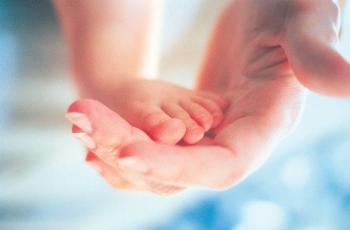
Hospital pushes skin-to-skin contact between parents, preemies
INDIANAPOLIS (AP) — Had everything gone according to plan, Cheyenne Blackford would have two more weeks before she delivered her first child. Her baby boy, Rhett, would be snug inside her, awaiting birth.
Life doesn’t always go according to plan. Rhett came into this world 86 days ago at a tiny 2 pounds, 2 ounces.
Still, a recent Monday found Rhett snug up against Cheyenne’s bare chest, where he spends an hour or so most days, enjoying the warmth and smell of his mother’s — or father’s — body, engaged in a practice known as kangaroo care, as Riley Hospital for Children at IU Health kicked off its first Kangaroo-a-Thon.
Riley Hospital, where Rhett has been since March 3, is encouraging parents whose children are in its neonatal intensive care unit, or NICU, to log a combined 600 hours of kangaroo care, skin-to-skin contact between parent and child.
Parents such as Cheyenne, who cuddled with Rhett tucked into a special shirt made just for “kangarooing,” won’t need much encouragement.
“There is nothing like it,” the Warsaw mother said. “It’s just the best feeling in the world.”
Kangaroo care was “discovered” by necessity about 30 years ago when a hospital in Bogota, Colombia, did not have enough incubators to house all its prematurely born babies. Doctors asked parents to hold their children to keep them warm.
Over time, experts noted that premature newborns cared for in this manner enjoyed a variety of benefits, including improved weight gain, heart rate stability and more restful sleep.
Now, neonatal experts want to see more parents engaging in the practice.
A Toronto hospital inspired the idea of a kangaroo-a-thon by challenging other children’s hospitals to a competition to see whose parents could log the most kangaroo care in two weeks.
Riley Hospital hasn’t participated but decided to test the idea to see how its parents would do. If its trial run goes well, Riley will participate in next year’s, said Lisa Schepper, a neonatal nurse practitioner.
Competition is fierce. This year, the Canadian hospital Sunnybrook Health Sciences Centre exceeded 1,028 hours of kangaroo care, far more than its goal of 605 hours.
Babies whose machinery or condition keeps them tethered to the crib may benefit from a modified version of kangaroo care — hand hugging, in which a parent cups the baby’s hands and feet.
Parents may hesitate at first, fearful to touch a delicate newborn, Schepper said.
“There’s some apprehension about bringing the baby out. Will that be OK? Once they do it, they love it,” she said. “Parents know immediately this is good for my baby.”
Riley has given parents who participate “scent bearers,” little kangaroos that volunteers have made of cotton or fleece. A mother places them next to her chest to pick up her scent and then puts them in her newborn’s crib so that her scent stays with her baby all day.
Hospitals can provide the bells and whistles of technology to help these tiny newborns survive, said Dr. Ulrike Mietzsch, co-director of Riley’s neuro-neonatal intensive care unit.
But kangaroo care, a low-tech but effective way to give these children another boost, falls solely to the parents, she said.
“This is something they can do to promote their baby’s development, which we can’t do,” she said.
- Log in to post comments
